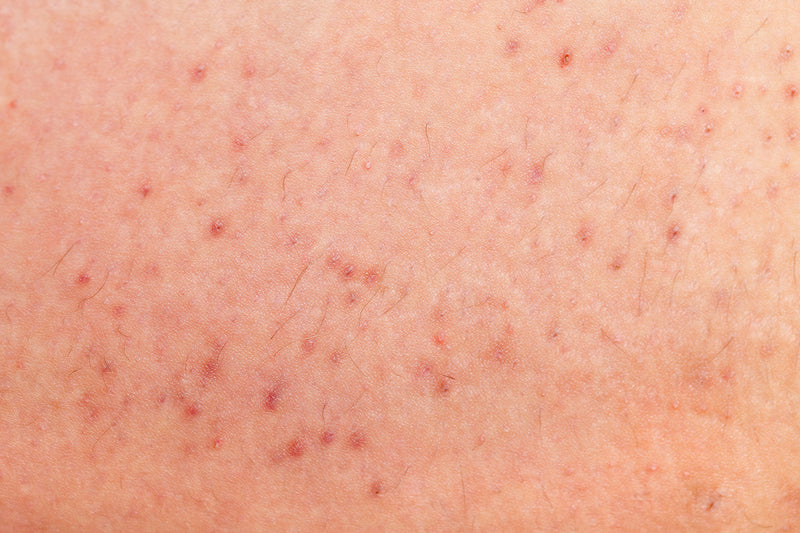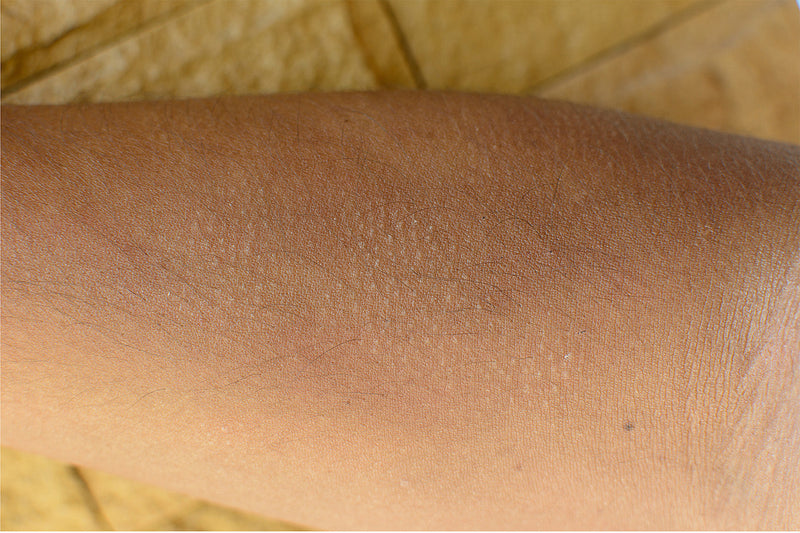
shaving has the potential to be an incredibly relaxing activity: light some candles, turn on your favorite music, jump into a hot shower, and get started.
shaving and caring for your body in a way that works for you is an excellent form of self-care, whether you’re taking it all off or just touching up some special spots.
hanni has all the tools you need to keep things sharp, hydrated, and ready for an oh-so-satisfying shave. but what happens when razor bumps crash the party?
no need to stress — you can help prevent these annoying little lumps by learning more about shaving itself, and a few simple treatments can help them go away asap.
how does shaving affect the skin?
we love shaving, but it can irritate your skin if you don’t do it with care. no matter where you choose to shave — whether it’s your face, armpits, legs, or bikini line — you shouldn’t rush the process. great things take time, after all.
every time you shave, you are grazing over hairs. this could irritate hair follicles as they grow back and cause razor bumps.
other skin concerns from shaving include razor burn, rashes, redness, and inflammation. these problems are often just the result of shaving too hastily and not giving your skin the tlc it needs during the process.
that is why it is so important to use some kind of moisturizer or shaving cream before shaving. don’t worry, hanni’s got you covered.
the hanni shave pillow is a mess-free stick that hydrates and protects your skin prior to shaving. just take off the cap, generously apply to the area you plan to shave, and then you’re ready to go! the best part is that the shave pillow is very portable. just keep it in your bag for hydration on the go.
we don’t want to be Debby Downers, here — we love shaving, and we know that it can do plenty of positive things for our skin, too.
when done mindfully, shaving can be a great tool to exfoliate the skin. using a single-blade razor (like the hanni weighted razor) gently shaves away dead skin cells on the top layer of the skin for a satisfyingly smooth sensation.
this post-shave skin can be great for applying other products. with the top layer of dead skin cells removed, other products will absorb better into the skin. we like the sound of that.
still, when little bumps in the road appear (pun intended), knowledge is definitely power.
what are razor bumps?
if you have razor bumps, you’ll know pretty quickly. they’re one of the most easily recognizable skin issues related to shaving.
these pesky red bumps can be simply diagnosed and treated at home, but you can always head to your trusty dermatologist if you’re ever in doubt.
they might recommend using topical treatment options like salicylic acid, glycolic acid, or an anti-inflammatory on the affected area. sometimes, however, razor bumps become too frequent or irritating. this could definitely get in the way of having a smooth shave and just kind of be a bummer throughout your day.
if you experience excessive razor bumps every time you shave, we recommend reaching out to a professional. they can offer you expert guidance on how to move forward with your skincare routine.
when razor bumps occur too often, they can lead to other issues because many people with excessive razor bumps often end up irritating the razor bumps over and over. we’re talking scarring, permanently raised bumps, and grooves in the skin. no, thank you!
while we know these little guys as razor bumps, dermatologists have a few different titles for this condition. it’s also known as pseudofolliculitis barbae, pseudofolliculitis pubis, barber’s itch, and folliculitis barbae traumatica — but we prefer using names we know how to spell.
no matter what you call them, they’re probably not your favorite thing to see when you wake up in the morning. razor bumps occur when hairs — often the curlier ones — get stuck inside of the hair follicle as they grow out of the skin. this leads to the hairs growing back into that top layer of skin, creating a bump.
according to dermatologists, people with naturally curly hair are most likely to develop razor bumps after shaving.
these red, inflamed, and sometimes painful bumps on the skin are also known as ingrown hairs. this is because the hair is growing into the skin instead of out of it.
how to avoid razor bumps
the first step to avoiding razor bumps is understanding your own skin.
do you have dry skin? oily skin? are you prone to acne or rashes? if you have prior skin concerns, talking to a dermatologist might be your best option to guarantee a smooth shave.
no matter what your skin type, though, there are a number of things you can do to avoid razor bumps.
shaving technique
dermatologists say that one of the most effective ways you can prevent razor bumps is to shave in the direction of hair growth. before you put the razor on your skin, look in the mirror and see if your hairs grow in one particular direction.
keeping a few days between shaving sessions can also help to reduce irritation.
shaving cream
hanni’s answer to shaving cream or shaving gel, the shave pillow is your best friend when it comes to pre-shave hydration. it smoothes the skin’s surface and makes it easier to avoid trapped hair after shaving.
a sharp blade
the single-blade design of the hanni weighted razor is the perfect tool for a close shave while exfoliating the skin. remember that blades should be switched out every two weeks or weekly for daily shavers.
this way, you’ll always be using the sharpest blade, and you can avoid the skin irritation that comes from using a dull blade.
exfoliate & open pores
before shaving, you can take the extra step of opening your pores and exfoliating your skin. using warm water and a washcloth (or our handy shower scarf), gently massage the skin you plan to shave.
the warmth will temporarily open your pores and prep your skin to help avoid razor bumps.
where do you choose to shave?
people decide to shave for a variety of reasons, and everyone is unique. some people prefer the smooth feel of freshly shaved legs. some shave their armpits because they like to apply deodorant more easily. some people shave their facial hair every day just because they prefer the look of it. no matter what area of your body you choose to shave (or not to shave), you should be prepared.
though you can use the hanni razor on any part of your body, the way you should shave differs slightly based on location. being aware of this can actually help to reduce the chance of developing razor bumps.
shaving in the direction of hair growth is always a good idea, but it’s especially helpful when you’re shaving your face.
you can figure out what way your hair grows by pulling your skin taut and looking closely at your skin or in a mirror to see what direction the hairs are facing. this is easier to see when the hair has grown out a bit.
some people, especially those with curly hair, do not have an identifiable direction in which their hair grows. no worries! dermatologists recommend that these people train their hair to grow together in the same direction. this is most important for people who choose to shave their face.
training your hair can actually be done with a toothbrush. use a clean, soft-bristled toothbrush to brush the hairs in a cohesive direction. you’ll see results if you do this daily, and hopefully, you will have reduced your chances of getting razor bumps. ta-da!
remedies: how to get rid of razor bumps
so, you moisturized with hanni’s shave pillow, shaved carefully, and took your time, but your skin is still irritated. ugh! unfortunately, you could do everything right and still end up with a few razor bumps on your skin.
some people just have sensitive skin or accidentally shave a little too quickly. no matter why your bumps appeared, we have some tips that can help you treat your irritated skin.
before you start to treat your razor bumps at home, you should know for sure that they are actually razor bumps and not some other similar-looking condition.
recurring or excessively painful razor bumps could be a sign of another issue. a skin condition called tinea barbae looks a lot like razor bumps or ingrown hairs. however, it is a fungal infection and needs different treatment. if you aren’t sure, reach out to a skincare expert. they’re experts for a reason!
if you do just have razor bumps, though, you’re in luck because they are relatively quick and easy to treat with home remedies and prescribed medication:
1. antibacterial lotions prescribed by a dermatologist
2. a warm compress with green tea bags
3. over-the-counter steroid creams
4. aloe vera
5. tea tree oil
6. a gentle exfoliating scrub
no more bumps
shaving for silky smooth skin can be a great part of your daily, weekly, or monthly routine. as nice as shaving can be, there are some things you should watch out for. shaving is skincare, so you need to keep an eye on your skin and how it reacts to shaving.
razor bumps are one of the ways in which the skin might negatively respond to being shaved. having the knowledge about your skin and the best ways to take care of it can be huge in preventing any bad reaction or rash from the razor. hanni has every product you need to get started with your smooth-shave journey. happy trails!
sources:
razor bump remedies for men with darker skin tones | american academy of dermatology
razor bumps: causes, home remedies, and treatment | healthline
why you should consider switching to a safety razor | advanced dermatology & skin cancer associates






